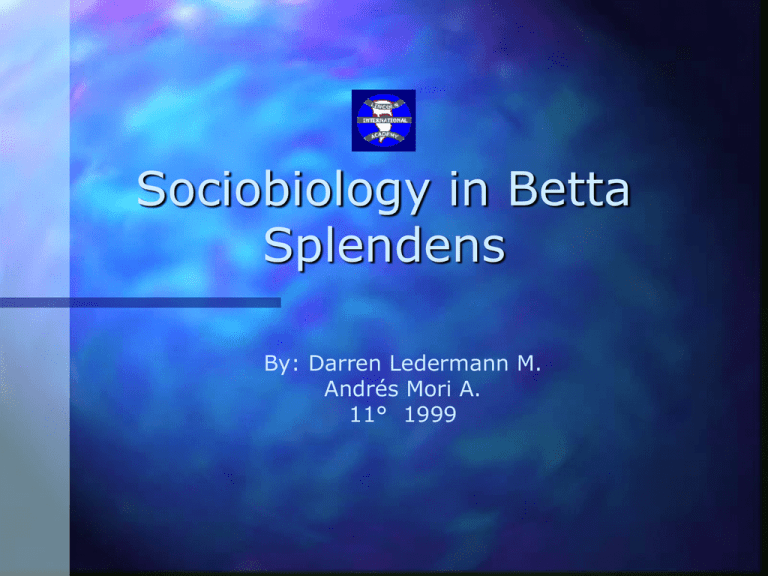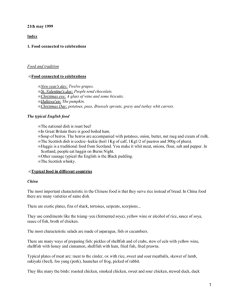Sociobiology
Anuncio

Sociobiology in Betta Splendens By: Darren Ledermann M. Andrés Mori A. 11° 1999 Classifying Sociobiology Konner: “A person is only a gene's way of making another gene” Broad Sociobiology Narrow Sociobiology Pop Sociobiology Broad Sociobiology It mainly refers to the study of animals and humans, providing answers to general questions concerning the mechanisms, development, function, and the evolution of all social behavior. Although this branch does not refer to a specific topic within sociobiology, it is believed that it is from this branch that both Narrow and Pop sociobiologies are born from. Narrow Sociobiology It bases it’s ideas on evolutionary theories to explain specific behaviors in both humans and animals. Within this field we can find the following theories which give supporting ideas: 1 .“Descent with Modification” (Darwin), which states that only the fittest of species on earth will continue to give birth to new generations and “descend”. This is the basis for stating “natural selection”, separating those species that will survive from those that won’t. 2. “Inclusive Fitness” (Hamilton), which states that animals will help those who share genes 3. “Game Theory” (Maynard Smith) , which is based on the “I give you something, maybe tomorrow I’ll be likely to get something” principle and 4. “Optimization Theory (Triver) , which bases its foundations on the trial-and-error principle: if the best answer for a problem can’t be acquired directly, an animal will continue to look for possible answers, finally reaching the best one. Pop Sociobiology Is an hypothetical approach which tries to confirm evolutionary explanations to claims about how they relate to human nature. Pop sociobiology also deals with evolution of items of human behavior and is based on a principle called Wilson’s ladder. This principle is the basic argument of pop sociobiologists, from which all other hypothesis on sociobiology start, this argument consists of six levels, these are: 1.IF a behavior maximizes fitness, THEN the behavior will exist in virtually all members of a group. 2.IF a behavior exists in virtually all members of a group, THEN the behavior came about by natural selection. 3.IF a behavior came about by natural selection, THEN there were once individual differences in the group's genetic makeup. 4.IF there were once individual differences in the group's genetic makeup, THEN there are differences in the genetic makeup of the present group from its prehistoric ancestors. 5.IF there are differences in the genetic makeup of the present group from its prehistoric ancestors, THEN the genetically adaptive behavior will be difficult to modify by social engineering. 6.THEREFORE, IF a behavior maximizes fitness, THEN the genetically adaptive behavior will be difficult to modify by social engineering One of the most known detractors of this argument is P. Kitcher. In his critique against pop sociobiology he states different reason that explain why Wilson`s ladder is not a solid argument for sociobiologists to rely on. Level 1: IF a behavior maximizes fitness, THEN the behavior will exist in virtually all members of a group. Pop sociobiology offers explanations of ecstasy at football games, forbearance in combat, and dominance displays in men, all in terms of maximizing fitness. However, the application of evolutionary principles may be overly hasty and unrigorous, not only when applied to humans, but even when applied to non-human animals. For example, one author (Orians, 1969) predicts that, in order to maximize fitness, virtually all swans, geese, and ducks should be polygamous. They are not. Therefore, the author introduces a new variable, high-latitude, and says that monogamy occurs only in high-latitude species. This conventionalist stratagem comprises a theoretically degenerating problemshift (Lakatos, 1970). Level 2: IF a behavior exists in virtually all members of a group, THEN the behavior came about by natural selection. Level 2 is essentially reductionistic, and thus all the criticisms of reductionism under the adaptationist program apply to level 2. One reductionist argument is that appeals to social engineering and history invoke illegitimate entities. However, the counterargument is that fitness maximizing behavior may become prevalent in a group through cultural transmission, without any changes in the gene pool (Kitcher, 1987). Level 4: IF there were once individual differences in the group's genetic makeup, THEN there are differences in the genetic makeup of the present group from its prehistoric ancestors. Evolution by natural selection destroys the genetic variance on which it feeds. Arguments about the evolution of present-day behavioral traits require information about genetic variation in the past. Regarding the heritability of behavioral dispositions (e.g., entrepreneurship), sociobiologists can play a game of "heads I win, tails you lose." If there is no genetic variation, then sociobiologists can claim that all variation was weeded out by selection for the trait. If there is genetic variation, then sociobiologists can claim that that is evidence that the trait is heritable (Lewontin, 1979). Level 5: IF there are differences in the genetic makeup of the present group from its prehistoric ancestors, THEN the genetically adaptive behavior will be difficult to modify by social engineering. The straightforward problem with level 5 is that even if we know that genes plus environment-1 produce a behavior, we don't know that genes plus environment-2 produce the same behavior. There are at least two possible responses to this problem. First, some human behavioral dispositions may predate the evolution of humans' prodigious cognitive abilities; therefore, those dispositions cannot be changed using those abilities. The rejoinder to this response is that special environmental sensitivity would seem, on the surface, to be a selective advantage (Kitcher, 1987). Second, certain human behavioral phenotypes may remain constant under diverse conditions (behavioral universals). The rejoinders to this response are two: (1) the previous rejoinder also applies in this case; (2) we must recognize the role of society in human development (Kitcher, 1987). Another example that proved Kitcher`s point is one of Wilson`s examples for sociobiology. His treatment of homosexuality claims that a propensity to have some homosexual offspring would boost one's inclusive fitness. To this, Kitcher argued the fact that here is no reason to believe in these alleged advantages, or that there is one category of homosexual behavior, as Wilson states. Experiment Materials 2 Betta Splendens fish 10 modeling clay-made false fish 10 modeling clay-made figures Separate containers for isolating the fish 1 other container for fighting purposes Experimental Procedures Training phase: 3 weeks, during which the modeled figures must be shown to the fish. Fighting phase: both fish are placed together in a single container. Experiment: Results and Conclusions The two specimens were differentiated as “Sandy” and “Papo”. The first one underwent a series of visual stimuli which were meant to increase its aggressiveness, in an attempt to artificially create an hyperagressive behavior in the fish, as described before. The second one, Papo, was kept in a typical home aquarium habitat, where it lived under regular conditions, maintaining its natural expectable behavior. During the last stage of the experiment, which was limited to two weeks instead of the originally planned three-week period, the two fish, which had been kept in different tanks for several purposes, such as keeping them isolated one form the other and being able to imprint certain behaviors in one of them only (Sandy), where placed together in the same tank as planned. Under regular circumstances both fish would normally start a fight for territory, with unpredictable results on which fish will eventually win the fight. Under this artificial circumstances we observed that Sandy engaged a furious thrust against Papo, which led to the expectable riot between both fish. As the fight took place, Sandy gained an unrecoverable advantage over its opponent, leading at the end of the fight to the death of Papo. During the fight we could see that Sandy’s main target on Papo’s body was its fins. On the other hand an involuntary experiment took place while we interacted with the fish. An unknown cat came into one of our homes, awakening the natural instinct of a dog to chase and try to eat the cat. After some time the chase continued, but surprisingly every time the dog had a clear chance to bite the cat it just pushed it aside with the nose. This natural experience proves the counterpart of our experiment: by posing an animal a continuous stimulus, the animal becomes calm and, say, familiar, to it, becoming calm instead of aggressive towards it. These observations that were recorded during the lapse of the fight allow us to infer that behavior can be directed (or “imprinted”) in a certain way in animals. What can make the difference in how an animal responds to a certain external stimulus resides mainly in the way these stimulus are shown to the animal in question as well as the level of evolution the animal has achieved, leading a same stimulus to have several different responses towards it, such as aggression or calmness. In this way we come to the following hypothesis: “Truth in science can be defined as the working hypothesis best suited to open the way to the next better one”. (Lorenz, "Quote Disk 1,2,3," by DBUG, 1991.) References Lakatos, I. (1970). Falsification and the methodology of scientific research programmes. In I. Lakatos & A. Musgrave (Eds.), Criticism and the growth of knowledge (pp. 91195). New York: Cambridge University Press. Orians, G. (1969). On the evolution of mating systems in birds and mammals. In T. luttonBrock & P. Harvey (Eds.), Readings in sociobiology. Freeman. Kitcher, P. (1987). Précis of Vaulting ambition: Sociobiology and the quest for human nature. Behavioral and Brain Sciences, 10, 61-100. Lewontin, R. C. (1979). Sociobiology as an adaptationist program. Behavioral Science, 24, 5-14. Daly, M., & Wilson, M. I. (1996). Violence against step-children. Current Directions in Psychological Science, 5, 77-81.

